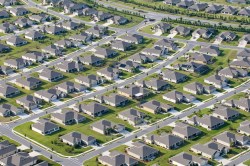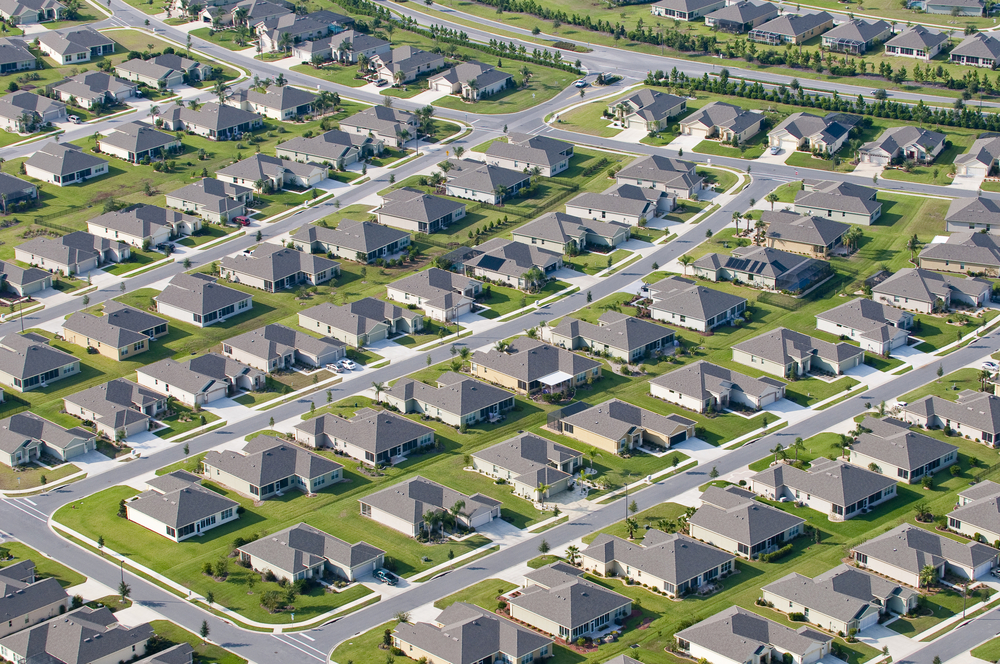
Shutterstock
You’re probably aware that the federal government spends money on some things you like (national parks), and some things you may not care for (imprisoning non-violent drug offenders). But you probably don’t know that the feds actually spend more money on real estate than practically anything else other than defense.
How so? As a new report illustrates, a variety of federal policies that go by other names are actually public investments in housing and other development. The report, “Federal involvement in real estate: A call for examination,” by the Washington, D.C.-based nonprofit Smart Growth America, adds it all up and finds approximately $450 billion each year in subsidies.
These public dollars, the report argues, collectively create an incentive for suburban sprawl and redistribute income from the poor to the rich. So much for the “war on suburbia.”
“Local governments are finding it hard to develop the walkable urban housing that is so in demand, and to leverage federal resources [for it],” said John McIlwain, senior housing fellow at the Urban Land Institute, on a conference call discussing the report.
Consider, for instance, the “mortgage interest tax deduction,” which allows people to deduct the interest on their home loan from their tax bill. The nominal purpose of the deduction is to promote home ownership. What it actually does is promote the over-consumption of housing relative to other forms of spending, savings, and investment, because it taxes a dollar spent on housing less than a dollar put elsewhere. It’s one reason that the average American house grew from 983 square feet in 1950 to 2,480 square feet in 2011.
How much do we taxpayers pour into the mortgage income tax deduction, you wonder? Only about $396 billion from 2007-2011, according to the report.
And that’s not all. Over the same five-year period, homeowners wrote off $106 billion in federal income tax liability using rules that allow you to deduct state and local property taxes from your taxable income. And then there is the exclusion of taxes on capital gains on the first $250,000, or $500,000 for a married couple, from the sale of a home. That accounted for another $94 billion in lost revenue over five years.
Collectively, these policies amount to a $680 billion federal subsidy to the housing sector over five years.
The even bigger federal investment in housing is the panoply of supports for obtaining home loans. The biggest, by far, is the Federal Housing Administration’s single-family loan program. The FHA guarantees mortgages, thus making credit available and mortgage interest rates lower. From 2007 through 2011 the FHA cost the government $1.1 trillion.
And the program is biased against mixed-use development in walkable urban environments: The FHA has historically refused to back mortgages for condos in buildings that are more than 25 percent commercial. They recently raised the limit to 35 percent — a step in the right direction, but on the whole, the program still tilts strongly toward houses (read: suburban-style development).
These subsidies also favor buying a home rather than renting. “Support for multifamily rental opportunities makes up only 15 percent of total housing support, despite the fact that 32 percent of U.S. households are renters,” says the Smart Growth report. Chalk it up as another pro-suburban bias, as a much higher proportion of suburbanites own their homes than do city dwellers. (It’s also biased against poor people, as renters also have a median household income of slightly less than half that of owners.)
Again, by putting their thumb on the scale when Americans decide between renting and buying, the government is pushing them out to the ’burbs.
These policies also discourage reinvigorating urban neighborhoods with old, undervalued housing stock. Imagine you have $1 million to spend on a house. If you spend $500,000 on buying a grand old Victorian house in the inner-city, needing $500,000 worth of renovations, you’ll get worse tax treatment than if you just spend the full $1 million on a new house in the suburbs.
The only support for renters comes through the Department of Housing and Urban Development, which provided $184 billion in direct subsidies and credits for low-income families over five years.
If we are going to spend all this money on the housing sector — a dubious proposition in the first place — it ought to go on helping those in need and generating the biggest return on our investment. That would mean investing in affordable housing near job opportunities, or mass transit to take you there, and filling in cities that could support more density.
“Federal funds are not targeted to those most in need, are not targeted to strengthen existing communities and are not targeted to places where people have economic opportunities,” says the Smart Growth report. As McIlwain said, “The focus on single family suburban development is misplaced.”
Instead, Smart Growth America argues, “Federal real estate spending and commitments should be coordinated around a clear set of goals to support thriving economies in communities across the country.”
Smart Growth America’s math demonstrates that President Obama’s celebrated efforts to make more intelligent federal investments in regional development are a drop in the bucket compared with the overflowing river of tax dollars propping up suburban sprawl and the market for single family homes. The White House’s request for the Sustainable Communities Initiative for 2011 was a paltry $150 million.
Grants of a few million dollars here or there to help build an apartment building next to a rail station are good, but creating a level playing field for different housing types, by removing all these counter-productive subsidies, would accomplish a lot more.


